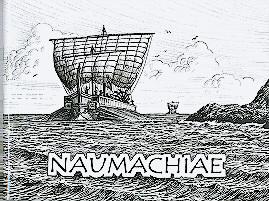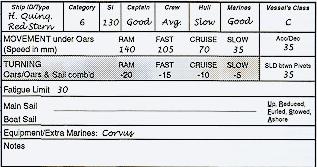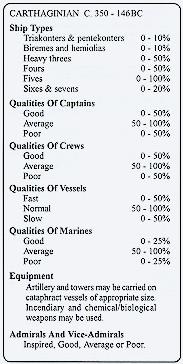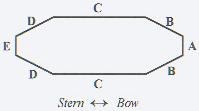

| |
Comprehensive rules covering galley combat over a 3,600-year span of history. Naumachiae is a Latin term (pronounced NAW-MAY-CHIA) that loosely translates as "Mock Sea Battles." Game is intended to play with at least a 2' x 2' playing area, and with a minimum of 10 ships per side. Fleets are assembled using a point system, with individual ship costs depending on their type (galley/barbarian ship/merchant ship) and sub-type (30 varieties of galley are listed), quality (rated by captain, crew, and hull), and equipment carried. General officers (admirals and vice admirals) are required according to fleet size, and also cost different points based on quality. Once fleets are designed, opponents determine initiative, placement of terrain (coastlines, islands, shallows, etc.), and the initial wind and weather conditions. Players alternate placing ships, using formations (line abreast, line astern, echelon).  Fleet Orders are issued before play begins, and determine what the fleet (or portion of the fleet) can do: Engage Enemy, Close With Enemy, Delay, Hold, Back Water, Withdraw, or Comply With Objective. Orders may subsequently be changed, but this requires a message to be successfully sent and received - with a chance for messages to be misunderstood. (Alternately, dispatch boats may be used to carry orders.) Once play begins, players alternate taking turns. The sequence is to check changes in weather or wind, check to receive messages, declare Ship Orders, then resolve ship movement/actions. Ship Orders must usually conform to Fleet Orders. To determine each ship's actions, an Ability Throw (dieroll) is made, then the results checked against a sequence of possible actions. Thus, a single dieroll may determine how well one ship fights a fire, maintains course, changes speed, fires its weapons, and sends signals. Players have the option of using one Ability Throw for multiple ships (speeding up play). Ships move at one of four speeds (Slow, Cruise, Fast, and Ram Speed), and must move a minimum distance between turns. Due to lack of proper keels, ships of this period may also suffer slight "mandatory turns" when trying to hold a straight course. Vessels which are too close to other friendly ships suffer maneuvering penalties, as do ships with are "overloaded" with equipment. Ships may incur Fatigue, but may recover by resting. Weapons fire during movement, and if contact occurs between ships, the "defending" (non-phasing) player may also fire. The types of weapons are artillery (heavy or light) and missiles (marines using javelins, bows or slings), plus boarding weapons (corvus, harpago, pots of bees or quicklime, fire pots). Weapons have an arc of fire, ranges (short/medium/long), and a damage score. Depending on the Ability Throw, weapons may do excess damage (calling for an Accurate Shooting Test), or may damage themselves or their own ships. Priority rules limit who can fire upon whom. Damage is also scored for oar raking, ramming, or collision, taking into effect speeds, angle of contact, and (in some cases) a Ram Test dieroll. A ship in contact with an enemy may attempt to board, resulting in a melee. As ships accumulate damage, they must make Damage Tests to avoid suffering penalties. Morale Tests may also be called for, which may result in anything from surrender to an urgent desire to attack. Rules also cover fires, repairs, using sails with oars, backing water, towing, beaching and grounding, dolphins (weights), friendly troops on shore, replacement of officers, and incendiaries. There is also a glossary.  The supplement booklet (included in the rules set) provides 22 Fleet Lists (guidelines for building fleets for particular periods and locales), as well as a brief history of ancient naval warfare and a treatise on tactics. Two introductory scenarios are provided (in the U.K., these are included with the ruleset; in the U.S., you may need to request these as the U.S. distributor is responsible for photocopying the sheets). Athens vs. Sparta (400 B.C.) and Carthage vs. Rome (250 B.C.) are training exercises more than battles, with both featuring only 3 ships per side. | ||||||||
|---|---|---|---|---|---|---|---|---|---|
| Period | Early Bronze Age (3,000 BC) to Byzantine Empire (600 AD) - the period of the development, supremacy, and decline of the ram-equipped galley. | ||||||||
| Scale |
| ||||||||
| Basing |  | ||||||||
| Contents | Ziploc bag encloses:
| ||||||||
| Designer | Martin Johncock, in conjunction with Rod Langton | ||||||||
| Publisher | First edition published 1998 by Langton Miniatures |
If you would like to add your opinion to this webpage, use the following form or send email to the editor.
If you know of other resources for this game, or if you have material you would like to make available to the Net, please let us know.
| Last Updates | |
|---|---|
| 28 November 1998 | pronunciation added |
| 27 November 1998 | page first published |
| Comments or corrections? | |